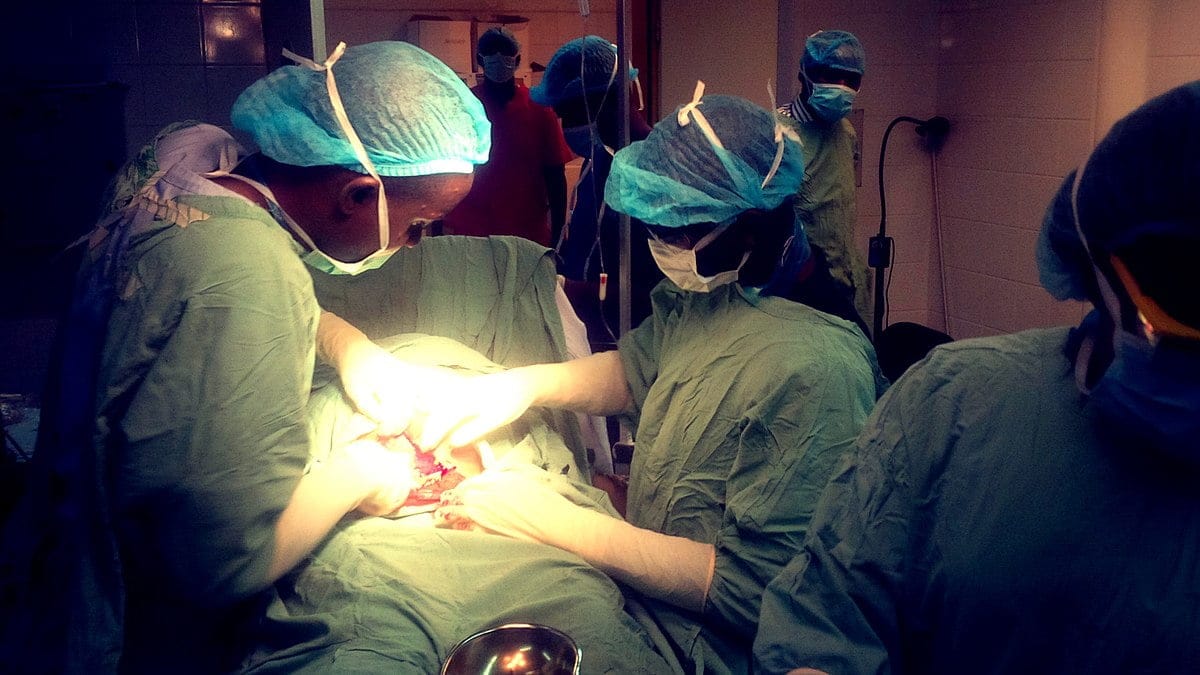 100% No Win No Fee
100% No Win No Fee
Award winning experts in medical negligence
To start your free case evaluation or to simply discuss
your options fill in our quick and easy form. A Devonshires Claims’ medical negligence lawyer will be in touch within 24 hours to help with your next steps.
* This data will be used by Devonshires Claims for processing your query and for no other purpose.
Negligence during a Cesarean section operation
A Cesarean section operation involves an incision in the lower part of the uterus through which the baby is delivered. As the bladder sits in front of the uterus, it must be pushed down to expose the part of the uterus the surgeon must cut.
Injuries to the bladder may occur during a C-Section – either when it is pushed down or when the surgeon makes a cut in the patient’s lower abdomen. Although there are accepted risks to a surgical procedure, the failure to appreciate the risks of a bladder injury and to make serious mistakes during a C-section could form the grounds to a compensation claim.

A Cesarean section operation involves an incision in the lower part of the uterus through which the baby is delivered. As the bladder sits in front of the uterus, it must be pushed down to expose the part of the uterus the surgeon must cut.
Injuries to the bladder may occur during a C-Section – either when it is pushed down or when the surgeon makes a cut in the patient’s lower abdomen. Although there are accepted risks to a surgical procedure, the failure to appreciate the risks of a bladder injury and to make serious mistakes during a C-section could form the grounds to a compensation claim.
If your bladder was cut or injured during your C-Section or your medical team failed to acknowledge the risks of a bladder injury occurring, you could be entitled to compensation.
Devonshires Claims’ medical negligence and compensation claims experts will carefully assess your C-Section and birth injury case and will tenaciously fight to obtain the maximum compensation for the injuries you have sustained. Our team are compassionate and driven, and we will put you in touch with other support services such as counsellors and clinical case managers who can help you recover.
For more information on Devonshires Claims ‘No Win No Fee’ C-section claims service or to start your free no-obligation case evaluation, please contact us today on 0333 900 8787, email [email protected] or complete our online form.
Surgical Mistakes During a C-Section
Bladder injury could result from cases of surgical negligence such as:
- The bladder was cut during the C-Section and the injury was not identified or repaired.
- The bladder was cut during the C-Section which caused urine to leak through the cut and into the abdominal cavity, causing an infection known as peritonitis.
- A ureter was cut during the C-Section and the injury was not identified or repaired
- The risks of a bladder injury occurring in the 2nd stage of birth was not accepted or acknowledged by the surgeon i.e. when a surgeon makes an incision to the skin, they should consider that the patient may be fully dilated, distorting the anatomy.
- The failure to acknowledge the risks of bladder injury in situations involving a prolonged labour with distended bladder.
- The failure to acknowledge the risks of bladder injury in situations e.g. Morbid adherent placenta (accreta, increta, and percreta) (Source: https://pubmed.ncbi.nlm.nih.gov/29157027/)
- The failure to acknowledge the potential risks a bladder injury associated with intra-abdominal adhesions, e.g., postoperative (nonuterine) pregnancy, chronic pelvic inflammatory disease, malignancy, irradiation etc.
- The failure to acknowledge the potential risks a bladder injury associated with Distorted local anatomy – cervical/lower segment fibroid, urogenital system anomaly.
- The failure to acknowledge the risk that women who’ve had previous c-sections are at a higher risk of bladder injury due to presence of scar tissue and adhesions.
“In some cases, cesarean delivery scarring can connect the uterus to the bladder. When they are connected, future cesarean deliveries are more likely to damage the bladder. Future pregnancies may also implant in dangerous areas, like the cesarean delivery scar.”
(Source: https://www.healthline.com/health/pregnancy/complications-cesarean-section#complications)
“It is important for clinicians caring for women undergoing both primary and subsequent Caesarean sections to consider and mitigate risk factors for scar tissue and adhesion development. Practitioners should maintain a high index of suspicion of blood dyscrasias and injury to surrounding organs and tissues during the pre- and post-natal periods. Failure to properly diagnose and promptly manage maternal complications may lead to adverse outcomes, including bladder rupture, massive haemorrhage, and other severe complications. Recognition of the aforementioned problems leads to improved outcomes and the ultimate safety of both patient and neonate.”
(Source: https://www.ncbi.nlm.nih.gov/pmc/articles/PMC7781874/)
- The failure to acknowledge the risks of a bladder injury in women with certain conditions eg. endometriosis, fibroids and Crohns disease
(Source: https://www.ajog.org/article/S0002-9378(20)31895-0/fulltext)
Symptoms of a cut to the bladder or ureters could include:
- Blood in the urine
- Bloating of the abdomen
- Abdominal pain
- Abnormal urinalysis results (elevated BUN and creatinine levels)
- and possible infections such as including peritonitis and sepsis
The risk of bladder injuries during a C-Section
According to the Royal College of Obstetricians and Gynecologists (RCOG), Caesarean sections carry a risk of bladder injury 1 in 1000 cases.
An NHS research project analysed ten years of maternity claims (1st April 2000 – 31st March 2010) i.e. 5,087 maternity claims with a total value of £3.1 billion. The findings (published in 2018; report entitled ‘Ten Years of Maternity Claims An Analysis of NHS Litigation Authority Data’) showed that the three most frequent categories of claim were those relating to:
- management of labour (14.05%),
- caesarean section (13.24%)
- and cerebral palsy (10.65%).

Cesarean section claims represented the 4th most common category in terms of value of a claim.

Urologic injuries involving the bladder are the most common injuries during a C-section. And with the increase of C-section procedures done either due to emergency or choice, these injuries are becoming more and more prevalent.
A cut to the bladder, during a C-section, is not usually life-threatening but when left unattended, the injury may have debilitating effects on the victims’ life. Some of the bladder injuries following a negligent C-section include:
- loss of bladder control and retention
- pain / discomfort when urinating
- neurogenic bladder (a lack of bladder control due to brain, spinal cord or nerve problems)
- urine leakage
- formation of vesico-uterine or vesico-vaginal fistula
The treatment may consist of the usage of a catheter to drain the bladder, bladder augmentation, and fistula repair surgeries.
When is a C-section required?
C-sections are life-saving procedures, and as Director of WHO’s Department of Sexual and Reproductive Health and Research and the UN joint Programme, Dr. Ian Askew, said:
“Caesarean sections are absolutely critical to save lives in situations where vaginal deliveries would pose risks, so all health systems must ensure timely access for all women when needed,”
The situations where a C-section may be required are:
- Placenta previa (Low-lying placenta)
- Breech position (babies’ feet are first)
- Low nutrient and oxygen levels affecting the baby
- Excessive vaginal bleeding
- Slow progressing labor
- Pre-eclampsia (high blood pressure related to pregnancy)
- Untreated HIV
- Certain infections, i.e., genital herpes that occurred late in the pregnancy
However, as Dr. Ian Askew also said:
“Not all the caesarean sections carried out at the moment are needed for medical reasons. Unnecessary surgical procedures can be harmful, both for a woman and her baby.”
Claiming compensation for bladder damage during a C-section
Surgical negligence during a C-Section could involve a cut to the bladder or ureters or the failure to prevent a bladder injury during the procedure.
If mistakes were made during your C-section and you sustained an injury to your bladder or ureters you could be entitled to make a compensation claim on a No Win No Fee basis.
Devonshires Claims’ highly experienced birth injury solicitors will support you through the whole process of obtaining compensation.
For more information on making a C-Section negligence claim or to start your free no-obligation case evaluation, call us today on 0333 900 8787, email [email protected] or complete our online contact form.


